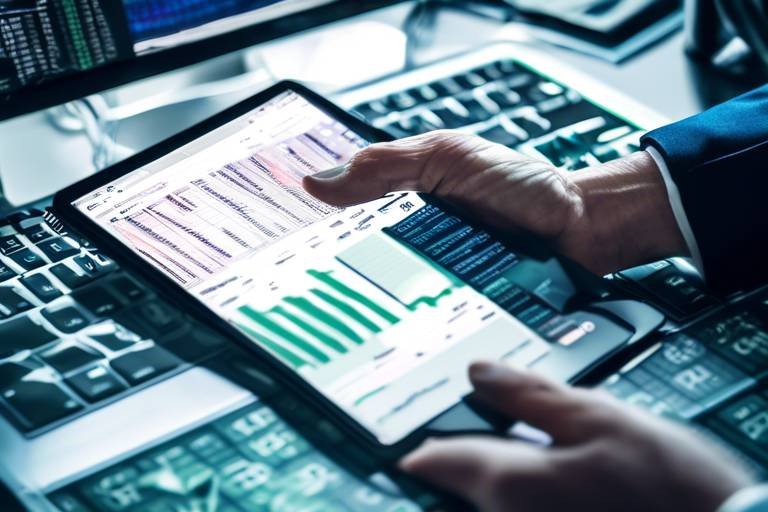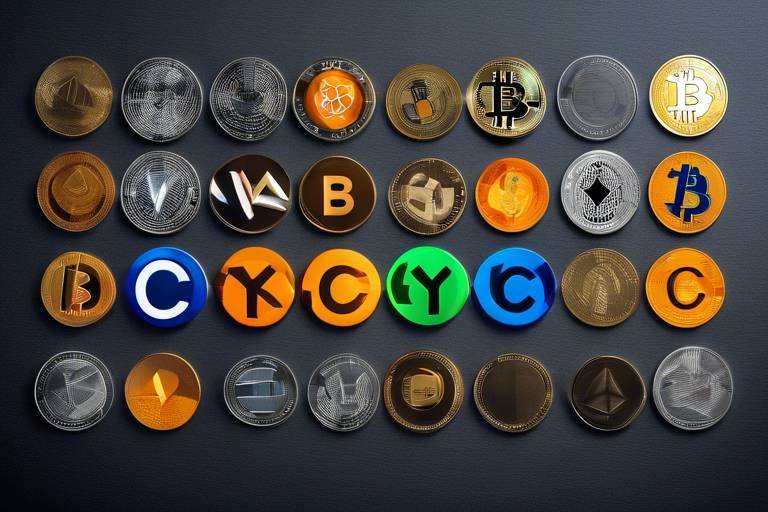Understanding the Risks of Margin Trading in Crypto
Margin trading in cryptocurrency is like walking a tightrope; one misstep can lead to significant financial consequences. It allows traders to borrow funds to amplify their trading positions, which can be enticing but also fraught with peril. Understanding the mechanics behind margin trading is essential for anyone looking to navigate the often-turbulent waters of the crypto market. By leveraging borrowed funds, traders can increase their potential profits, but they also expose themselves to heightened risks. So, how do you balance the allure of increased returns with the looming threat of losses?
To grasp the complexities of margin trading, it's vital to familiarize yourself with terms like "leverage," "liquidation," and "maintenance margin." The concept of leverage is particularly important; it allows traders to control a larger position than they could with their own capital alone. However, while leverage can amplify profits, it can just as easily amplify losses, turning a small market movement into a devastating financial blow. This paradox is what makes margin trading both attractive and dangerous.
In the world of crypto, where prices can swing wildly within minutes, the stakes are even higher. Traders must be vigilant and informed, constantly monitoring their positions and the market. The mechanics of margin trading require a solid grasp of risk management strategies to safeguard against potential pitfalls. After all, in a market as volatile as cryptocurrency, the last thing you want is to be caught off guard when the tides turn unexpectedly.
Moreover, the psychological aspect of margin trading cannot be overlooked. The thrill of potential profits can cloud judgment, leading traders to make impulsive decisions. This emotional rollercoaster can result in over-leveraging, where traders borrow more than they can afford to lose. It’s crucial to approach margin trading with a clear mind and a well-thought-out strategy to mitigate these risks effectively.
Margin trading allows investors to borrow funds to increase their trading position. Understanding its fundamental principles is crucial for navigating the crypto market effectively.
Margin trading carries significant risks, including the potential for substantial losses. This section delves into the various risk factors that traders should be aware of before engaging in margin trading.
Liquidation occurs when a trader's margin account falls below the required maintenance margin. This section explains how and when liquidations happen, and their implications for traders.
Various factors can trigger forced liquidation, including market volatility and insufficient collateral. Understanding these triggers helps traders manage their positions more effectively.
Market volatility can drastically affect margin positions. This subsection discusses how sudden price swings can lead to unexpected liquidations and losses.
Using leverage amplifies both potential gains and losses. This part examines the dangers of excessive leverage and how it can lead to catastrophic financial outcomes.
Effective risk management strategies are essential for successful margin trading. This section outlines various approaches traders can adopt to minimize their exposure to risks.
Diversifying a trading portfolio can help reduce risks associated with margin trading. This subsection discusses how spreading investments across different assets can protect against significant losses.
Implementing stop-loss orders is a vital strategy for managing risk. This section explores how setting these orders can safeguard against major downturns in the market.
In conclusion, understanding the risks of margin trading in crypto is crucial for traders. Informed decision-making and proper risk management can help navigate the volatile landscape of cryptocurrency trading.
- What is margin trading? Margin trading allows traders to borrow funds to trade larger positions than their capital would normally allow.
- What are the risks of margin trading? The primary risks include liquidation, market volatility, and the dangers of excessive leverage.
- How can I mitigate risks in margin trading? Strategies include diversification, setting stop-loss orders, and maintaining a disciplined approach to trading.
- What happens during liquidation? Liquidation occurs when a trader’s account equity falls below the required maintenance margin, forcing the broker to close positions to recover losses.

The Basics of Margin Trading
Margin trading is like taking a leap into the deep end of the pool—exciting, but it comes with its own set of challenges and risks. At its core, margin trading allows investors to borrow funds to amplify their trading positions. This means that instead of just using your own money, you can leverage borrowed capital to trade larger amounts, potentially leading to greater profits. However, the flipside is that it can also lead to significant losses if things don’t go as planned. Understanding the fundamental principles of margin trading is crucial for anyone looking to navigate the often turbulent waters of the cryptocurrency market.
To get started with margin trading, you typically need to open an account with a brokerage or exchange that offers this service. Once your account is set up, you can deposit funds and start trading. The amount you can borrow is usually determined by the leverage ratio set by the platform. For example, if you have a leverage of 2:1, you can trade with two times the amount of your initial investment. This can be thrilling, as it allows you to maximize your potential returns, but it also means that your losses can be magnified just as easily.
Let’s break down the essential components of margin trading:
- Initial Margin: This is the minimum amount of equity you need to deposit to open a margin position. Think of it as your entry ticket to the trading arena.
- Maintenance Margin: After opening a position, you must maintain a certain level of equity in your account. If your account balance falls below this threshold, you may face a margin call.
- Margin Call: This is a warning from your broker that you need to deposit more funds or close positions to meet the maintenance margin requirement. Ignoring a margin call can lead to forced liquidation.
The mechanics of margin trading can be complex, but grasping these basics is vital. Think of margin trading as a double-edged sword; it can cut both ways. While it offers the potential for increased profits, it also heightens the risk of significant losses. Therefore, it’s essential to approach margin trading with caution and a well-thought-out strategy. As you venture into this realm, always remember that knowledge is your best ally. The more you understand about how margin trading works, the better equipped you’ll be to make informed decisions and navigate the crypto landscape effectively.

Potential Risks Involved
When diving into the world of margin trading, it’s essential to recognize that while the potential for profit is enticing, the risks involved can be significant. Margin trading allows traders to borrow funds to amplify their positions, but this leverage can also lead to substantial losses. Imagine standing on the edge of a high cliff; one misstep could send you tumbling down, and that’s exactly how margin trading can feel if you’re not careful. To truly understand the potential pitfalls, let’s explore some of the most critical risks that traders face.
One of the most pressing risks is liquidation. This occurs when the value of your margin account falls below the required maintenance margin. Essentially, if the market moves against your position, you might be forced to sell your assets at a loss to cover your borrowed funds. Picture this: you’ve invested heavily in a cryptocurrency, and suddenly the price drops sharply. If your account balance can’t support the margin requirement, the exchange will automatically liquidate your position. This can happen in the blink of an eye, leaving you with nothing but regret.
Understanding when and how liquidations happen is crucial. Typically, liquidations occur due to a combination of market volatility and insufficient collateral. For instance, if you’re trading with a 10x leverage and the market moves just 10% against you, your entire position could be liquidated. This is the harsh reality of margin trading, where even small price fluctuations can have devastating effects.
Several factors can trigger forced liquidation, including:
- Market Volatility: Sudden price swings can catch traders off guard.
- Insufficient Collateral: If your collateral drops in value, it may not meet the margin requirements.
- High Leverage: The more you leverage, the closer you are to liquidation thresholds.
By being aware of these triggers, traders can take proactive steps to manage their positions more effectively and avoid the dreaded liquidation scenario.
Market volatility is another beast that margin traders must tame. In the crypto world, prices can swing wildly within minutes, and this unpredictability can lead to unexpected liquidations. Think of it like a rollercoaster ride; one moment you're climbing to new heights, and the next, you’re plummeting down. A sudden drop in price can wipe out your margin, and if you’re not prepared, you could find yourself in a precarious financial situation. Therefore, keeping an eye on market trends and using tools like stop-loss orders becomes vital in navigating these turbulent waters.
Leverage is a double-edged sword. While it can amplify your gains, it can just as easily amplify your losses. Using excessive leverage is akin to playing with fire; it can lead to catastrophic financial outcomes if not handled correctly. Many new traders underestimate the risks associated with high leverage, thinking they can turn a small investment into a fortune overnight. However, the reality is often the opposite—many end up losing more than they initially invested. The key takeaway here is to use leverage wisely and to understand that with greater potential rewards come greater risks.
In conclusion, margin trading is not for the faint of heart. The potential risks, from liquidation to market volatility and the dangers of leverage, require a solid understanding and a cautious approach. By being aware of these risks, traders can make informed decisions and implement strategies to mitigate potential losses.
1. What is margin trading?
Margin trading involves borrowing funds to increase the size of your trading position, allowing for greater potential returns but also increased risk.
2. How does liquidation work?
Liquidation occurs when your account balance falls below the required margin, forcing the exchange to sell your assets to cover the borrowed amount.
3. What are the risks of using high leverage?
High leverage can lead to significant losses, as even small market movements can trigger liquidations, wiping out your investment.
4. How can I protect myself from liquidation?
Implementing strategies such as setting stop-loss orders, maintaining adequate collateral, and avoiding excessive leverage can help protect against liquidation.
5. Is margin trading suitable for beginners?
Margin trading carries substantial risks and may not be suitable for beginners without a strong understanding of the market and risk management strategies.

Liquidation Risks
When diving into the world of margin trading, one of the most critical aspects to understand is . Liquidation happens when the value of your collateral falls below the required maintenance margin, leading your broker or exchange to close your position to prevent further losses. Essentially, it’s like a safety net that can quickly turn into a trap if you're not careful. Imagine walking a tightrope; one misstep and you could find yourself plummeting into a sea of losses.
So, how does this process unfold? When you open a margin position, you borrow funds to amplify your potential gains. However, this also means that any losses are magnified. If the market moves against your position, and your account balance dips below a certain threshold, the exchange will automatically liquidate your assets. This can happen faster than a blink, especially in the notoriously volatile cryptocurrency market.
Let’s break down the key factors that can lead to liquidation:
- Market Volatility: Cryptocurrencies are known for their rapid price fluctuations. A sudden drop in price can trigger a liquidation event, even if you're just slightly below the maintenance margin.
- Insufficient Collateral: If the collateral you provided isn't enough to cover your losses, the exchange will step in to protect itself by liquidating your position.
- Leverage Used: The more leverage you use, the smaller the price movement needs to be for liquidation to occur. High leverage can be a double-edged sword.
Understanding these triggers can help you manage your positions more effectively. It's essential to keep a close eye on your margin levels and the overall market conditions. You wouldn’t want to be caught off guard, watching helplessly as your investments vanish in a matter of seconds.
Moreover, it's important to remember that liquidation isn’t just a one-time event; it can have lasting impacts on your trading strategy and psychological state. The fear of losing everything can lead to hasty decisions, which might further exacerbate your losses. Therefore, having a solid grasp of liquidation risks is not just beneficial—it's crucial for anyone engaging in margin trading.
In summary, liquidation risks are an inherent part of margin trading. Being aware of how and when liquidations occur can significantly affect your trading outcomes. Prepare yourself with knowledge and strategies to stay afloat in the turbulent waters of cryptocurrency trading.
- What is liquidation in margin trading? Liquidation is the process of closing a trader's position when their account equity falls below the required maintenance margin.
- How can I avoid liquidation? To avoid liquidation, maintain a healthy margin level, use lower leverage, and set stop-loss orders.
- What happens after my position is liquidated? Once a position is liquidated, you lose the collateral you put up, and your account balance may be significantly reduced.

Forced Liquidation Triggers
When it comes to margin trading in cryptocurrency, understanding the concept of forced liquidation is paramount. This scenario unfolds when a trader's account balance dips below the required maintenance margin, prompting the exchange to liquidate their positions. But what exactly triggers this alarming process? Let's delve into the factors that can lead to forced liquidation, ensuring that you're well-equipped to navigate these turbulent waters.
One of the primary triggers for forced liquidation is market volatility. In the fast-paced world of crypto, prices can swing dramatically in a matter of minutes. Imagine waking up to find that the asset you invested in has plummeted by 30% overnight; this sudden drop could easily push your margin account into the danger zone. It's like walking a tightrope—one misstep, and you're in free fall!
Another critical factor is insufficient collateral. When you open a margin position, you're required to maintain a certain level of collateral to back your trades. If the value of your collateral decreases significantly due to market fluctuations, your position may become under-collateralized. This situation is akin to trying to hold a beach ball underwater; eventually, the pressure builds up, and something has to give. In this case, the exchange will step in to liquidate your position to protect itself from potential losses.
In addition to market volatility and collateral issues, high leverage also plays a crucial role in triggering forced liquidations. Traders often use leverage to amplify their potential gains, but this double-edged sword can just as easily magnify losses. For example, if you're trading with 10x leverage and the market moves against you by just 10%, you could find yourself liquidated, losing your entire investment in the process. It’s a risky gamble that can lead to devastating outcomes.
To summarize, the key triggers for forced liquidation include:
- Market Volatility: Sudden price drops can quickly deplete your margin account.
- Insufficient Collateral: A decrease in the value of your collateral can lead to under-collateralization.
- High Leverage: Amplified losses can occur with high leverage, resulting in forced liquidation.
Understanding these triggers is essential for traders who wish to minimize their risk exposure. By keeping an eye on market conditions, managing collateral effectively, and using leverage judiciously, you can navigate the perilous waters of margin trading with greater confidence. Remember, in the world of crypto, knowledge is your best ally!
- What is forced liquidation? Forced liquidation occurs when a trader's margin account falls below the required maintenance margin, leading the exchange to automatically close positions to prevent further losses.
- How can I avoid forced liquidation? To avoid forced liquidation, maintain sufficient collateral, monitor market volatility, and use leverage cautiously.
- What happens after liquidation? After liquidation, the trader loses their position and any funds that were in the margin account that were not covered by the collateral.

Impact of Market Volatility
Market volatility is like a rollercoaster ride—exciting, yet terrifying. When it comes to margin trading in cryptocurrency, understanding how volatility affects your positions is crucial. Picture this: you’ve borrowed funds to amplify your trading position, and suddenly, the market takes a nosedive. What happens next can be disastrous. Volatility can lead to rapid price swings, often within minutes, which can trigger forced liquidations and substantial losses.
In the world of crypto, where prices can fluctuate wildly, traders are particularly vulnerable. For instance, a sudden drop in Bitcoin’s value can cause a ripple effect across the entire market, impacting other cryptocurrencies as well. This is not just a theoretical scenario; it happens regularly. Let’s break down how market volatility can impact your margin trading experience:
- Increased Risk of Liquidation: When prices drop sharply, your margin account can quickly fall below the maintenance margin requirement, leading to liquidation. This means your positions are forcibly closed to cover the losses, often at the worst possible moment.
- Psychological Stress: The emotional toll of watching your investment fluctuate can cloud your judgment. Fear and panic can lead to hasty decisions, such as closing positions prematurely or failing to act when necessary.
- Margin Calls: A volatile market can trigger margin calls, where your broker demands additional funds to maintain your position. If you’re unable to meet this requirement, you risk losing your investment.
To illustrate the impact of market volatility, consider the following table that outlines potential scenarios for a trader using 2x leverage during a volatile market:
| Scenario | Initial Investment | Market Price Change | Final Outcome |
|---|---|---|---|
| Price Increase | $1,000 | +20% | $2,000 Profit |
| Price Decrease | $1,000 | -20% | Liquidation at $800 |
As demonstrated, while a price increase can double your investment, a mere 20% drop can lead to liquidation—highlighting the double-edged sword of leverage in a volatile market. The key takeaway here is to be aware of the inherent risks that come with trading in such an unpredictable environment.
In conclusion, navigating the impacts of market volatility requires not just awareness but also a solid strategy. Whether it’s through setting appropriate stop-loss orders, diversifying your portfolio, or simply staying informed about market trends, being proactive can help you mitigate the risks associated with these wild swings in the cryptocurrency market.
- What is margin trading? Margin trading involves borrowing funds to increase the size of your trading position, allowing for potentially higher returns but also higher risks.
- How does market volatility affect margin trading? Market volatility can lead to rapid price changes, increasing the risk of liquidation and margin calls, which can result in significant losses.
- What strategies can help manage risks in margin trading? Strategies such as setting stop-loss orders, diversifying your portfolio, and maintaining a clear understanding of market conditions can help manage risks effectively.

Leverage and Its Dangers
When it comes to margin trading, leverage is a double-edged sword. It allows traders to control a larger position than their initial capital would allow, which can be incredibly enticing. Imagine you have $1,000 in your trading account, and with 10x leverage, you can trade as if you had $10,000! Sounds great, right? But here's the catch: while leverage can amplify your profits, it can also magnify your losses just as quickly. This is where the real danger lies.
Many traders, especially newcomers, fall into the trap of thinking that they can only win when using high leverage. However, what they often overlook is that the same factors that can lead to substantial gains can also wipe out their entire investment in a heartbeat. For instance, if the market moves just 10% against your leveraged position, you could lose your entire $1,000 investment. This is why understanding how leverage works is crucial before diving into margin trading.
To illustrate the potential risks associated with leverage, consider the following table that outlines different leverage levels and their corresponding risk factors:
| Leverage Level | Potential Gain | Potential Loss |
|---|---|---|
| 2x | 20% | 10% |
| 5x | 50% | 20% |
| 10x | 100% | 50% |
| 20x | 200% | 100% |
This table clearly shows how higher leverage can lead to greater potential gains but also significantly increases the risk of loss. Thus, while the allure of huge profits can be tempting, it’s essential to approach leverage with caution. Many traders find themselves in a precarious position when they rely too heavily on leverage without a solid risk management strategy in place.
Furthermore, the emotional aspect of trading with leverage cannot be ignored. The fear of losing money can lead to impulsive decisions, causing traders to either hold onto losing positions too long or exit winning trades prematurely. This psychological rollercoaster can be detrimental, leading to a cycle of poor decision-making that can amplify losses even further.
So, how can traders protect themselves from the dangers of leverage? Here are some strategies:
- Use lower leverage: Start with a lower leverage ratio to minimize risk.
- Set strict stop-loss orders: Always protect your capital by setting stop-loss orders to limit potential losses.
- Educate yourself: The more you know about how leverage works, the better equipped you'll be to handle its risks.
In summary, while leverage can be a powerful tool in the world of margin trading, it comes with significant risks that traders must be aware of. By understanding these dangers and implementing effective risk management strategies, traders can navigate the volatile waters of cryptocurrency trading more safely.
- What is leverage in margin trading? Leverage allows traders to borrow funds to increase their trading position, potentially amplifying both gains and losses.
- How does leverage affect risk? Higher leverage increases both the potential for profit and the risk of substantial losses, making it crucial to manage risk effectively.
- What is a stop-loss order? A stop-loss order is a tool used to limit potential losses by automatically selling a position when it reaches a certain price.
- Can I lose more than my initial investment with leverage? Yes, trading with high leverage can lead to losses that exceed your initial investment, especially if the market moves against your position.

Strategies to Mitigate Risks
When it comes to margin trading in cryptocurrency, the stakes can be incredibly high. However, there are several effective strategies that traders can employ to mitigate risks and protect their investments. Understanding these strategies is crucial because, in the fast-paced world of crypto, even a small misstep can lead to significant losses. Let's dive into some of the most effective methods to safeguard your margin trading endeavors.
One of the most important strategies is diversification. Just like you wouldn’t put all your eggs in one basket, spreading your investments across different cryptocurrencies can help cushion against market volatility. By diversifying your portfolio, you can minimize the impact of a downturn in any single asset. For instance, if Bitcoin experiences a sharp decline, having investments in other altcoins like Ethereum or Litecoin can potentially offset those losses. Here’s a quick look at how diversification can work:
| Asset Type | Potential Risk | Benefit of Diversification |
|---|---|---|
| Bitcoin | High volatility | Reduced overall risk |
| Ethereum | Moderate volatility | Stable returns |
| Altcoins | Variable volatility | Opportunity for high gains |
Another critical strategy is the implementation of stop-loss orders. This tool acts as a safety net, allowing traders to set a predetermined price at which their position will automatically close to prevent further losses. For example, if you purchase a cryptocurrency at $100 and set a stop-loss at $90, your position will close if the price falls to that level, limiting your loss to 10%. This is particularly useful in the volatile crypto market where prices can swing dramatically in a short time.
Moreover, it’s essential to maintain a level of emotional discipline while trading. Fear and greed can lead to impulsive decisions that may not align with your trading strategy. Establishing a clear plan and sticking to it, regardless of market fluctuations, can help you avoid the pitfalls of emotional trading. Consider setting specific goals for both profits and losses to guide your trading decisions.
Lastly, continuous education is a powerful risk mitigation strategy. The crypto market is ever-evolving, and staying informed about market trends, technological advancements, and regulatory changes can provide you with the insights needed to make informed trading decisions. Engaging with reputable sources of information, attending webinars, or participating in trading communities can enhance your understanding and help you navigate the complexities of margin trading.
- What is margin trading? Margin trading involves borrowing funds to increase your trading position, allowing for potentially larger profits but also greater risks.
- How can I manage my risks in margin trading? Strategies such as diversification, setting stop-loss orders, maintaining emotional discipline, and continuous education can help manage risks effectively.
- What is a stop-loss order? A stop-loss order is a predetermined price at which your position will automatically close to prevent further losses.
- Why is emotional discipline important in trading? Emotional discipline helps prevent impulsive decisions driven by fear or greed, allowing you to stick to your trading strategy.

Diversification Techniques
Diversification is like spreading your bets across different horses in a race; it reduces the risk of losing everything on a single outcome. In the world of margin trading, particularly in the volatile crypto market, this strategy becomes even more crucial. By diversifying your investments, you can mitigate the potential impact of a downturn in any single asset. Imagine if you invested all your funds into one cryptocurrency, only to see its value plummet overnight due to unforeseen market conditions. That scenario can be devastating, but if you had spread your investments across multiple cryptocurrencies, the adverse effects could be significantly cushioned.
When considering diversification techniques, it's essential to think about a variety of factors, including market sectors, asset types, and even geographical regions. For instance, you might choose to invest in a mix of established coins like Bitcoin and Ethereum, alongside promising altcoins that have the potential for rapid growth. This blend not only helps in balancing risk but also opens up opportunities for higher returns.
Here are some effective diversification techniques to consider:
- Asset Class Diversification: Don't limit yourself to just cryptocurrencies. Consider including other asset classes like stocks, bonds, or commodities in your portfolio. This approach can provide a safety net against the inherent volatility of the crypto market.
- Sector Diversification: Within the crypto space, different sectors may perform differently based on market trends. For example, while DeFi (Decentralized Finance) projects might be booming, NFTs (Non-Fungible Tokens) could be experiencing a downturn. By investing across these sectors, you can reduce your overall risk.
- Geographical Diversification: Cryptocurrencies are not limited to any single country or region. Investing in projects from various geographical locations can help shield your portfolio from local market fluctuations and regulatory risks.
In addition to these techniques, it’s also vital to regularly review and adjust your portfolio. The crypto market is dynamic, and what worked yesterday might not work tomorrow. Keeping an eye on market trends and being ready to shift your investments can be the difference between profit and loss.
Ultimately, the goal of diversification is to create a balanced portfolio that can withstand the unpredictable nature of crypto trading. By employing these techniques, you can navigate the turbulent waters of margin trading with more confidence and less fear.
Q1: What is diversification in trading?
A1: Diversification in trading refers to the practice of spreading investments across various assets or sectors to reduce risk. By not putting all your eggs in one basket, you can protect your portfolio from significant losses.
Q2: How does diversification help in margin trading?
A2: In margin trading, diversification can help mitigate the risks associated with high volatility. If one asset underperforms, others in your portfolio may perform well, balancing out potential losses.
Q3: Can I diversify within cryptocurrencies alone?
A3: Yes, you can diversify within cryptocurrencies by investing in different types of coins and tokens, such as established cryptocurrencies, altcoins, and tokens from various sectors like DeFi and NFTs.
Q4: How often should I review my diversified portfolio?
A4: It is advisable to review your portfolio regularly, at least quarterly or whenever there are significant market changes. This helps you stay informed and make necessary adjustments to your investments.

Setting Stop-Loss Orders
When diving into the world of margin trading, one of the most effective tools at your disposal is the stop-loss order. Think of it as your safety net; it’s designed to limit your losses and protect your investment from the unpredictable swings of the cryptocurrency market. Just like a seatbelt in a car, it’s there to keep you secure when things get bumpy. But how exactly do stop-loss orders work, and why are they essential for traders?
At its core, a stop-loss order is a predefined instruction to sell a cryptocurrency when its price falls to a certain level. This level is known as the stop price. For instance, if you purchased Bitcoin at $50,000 and want to limit your potential loss to 10%, you might set a stop-loss order at $45,000. If Bitcoin's price drops to this level, the order is triggered, and your position is sold automatically. This helps you avoid emotional decision-making during times of market stress.
However, it’s important to remember that while stop-loss orders can be a lifesaver, they are not foolproof. Market conditions can change rapidly, and in extreme cases, the execution price may be lower than your stop price, especially during periods of high volatility. This phenomenon is known as slippage, and it can lead to greater losses than you might have anticipated. Therefore, it’s crucial to set your stop-loss orders wisely.
Here are a few tips to effectively set stop-loss orders:
- Analyze Market Trends: Before setting your stop-loss, take the time to analyze the market trends. Understanding the historical price movements can help you set a more strategic stop price.
- Consider Support Levels: Look for key support levels in the price chart. Setting your stop-loss just below these levels can provide a buffer against minor fluctuations.
- Adjust as Needed: As your trade progresses, don’t hesitate to adjust your stop-loss order. If your position becomes profitable, consider moving the stop-loss to a break-even point or higher to lock in gains.
In conclusion, setting stop-loss orders is a fundamental strategy for managing risk in margin trading. It not only helps to protect your capital but also allows you to trade with more confidence. By incorporating this tool into your trading strategy, you can navigate the choppy waters of the crypto market with a bit more peace of mind.
- What is a stop-loss order? A stop-loss order is an instruction to sell a cryptocurrency when its price falls to a specified level, helping to limit potential losses.
- Can a stop-loss order guarantee that I won’t lose money? No, while stop-loss orders can help manage risk, they do not guarantee that you won’t incur losses due to market volatility and slippage.
- How do I determine the right stop price? Analyze market trends, consider support levels, and adjust as necessary based on your trading strategy and risk tolerance.

Conclusion: Making Informed Decisions
In conclusion, understanding the risks of margin trading in crypto is crucial for traders who wish to navigate this volatile landscape effectively. The world of cryptocurrency is akin to a roller coaster ride—thrilling yet unpredictable. By being aware of the potential pitfalls, such as liquidation risks and the dangers of excessive leverage, traders can make informed decisions that align with their financial goals.
It's essential to remember that margin trading isn't just about the potential for high returns; it's also about the responsibility that comes with it. Just as a skilled surfer knows when to ride a wave and when to paddle back to shore, successful traders must develop a keen sense of market dynamics and risk management strategies. Implementing techniques such as diversification and setting stop-loss orders can act as life jackets, helping to keep your investments afloat during turbulent times.
Moreover, the importance of continuous learning and adaptation cannot be overstated. The cryptocurrency market is constantly evolving, and staying updated with market trends, news, and technological advancements is vital. Traders should consider engaging with educational resources, participating in online forums, and following reputable analysts to enhance their understanding and decision-making skills.
Ultimately, the key to thriving in margin trading lies in balancing risk and reward. By adopting a disciplined approach and employing effective risk management strategies, traders can navigate the complexities of margin trading while minimizing potential losses. Remember, every decision you make should be backed by thorough research and a clear understanding of your financial situation.
- What is margin trading? Margin trading involves borrowing funds to increase the size of your trading position, allowing for potentially higher profits but also greater risks.
- What are the main risks of margin trading? The main risks include liquidation, excessive leverage, and market volatility, all of which can lead to significant financial losses.
- How can I mitigate risks in margin trading? Strategies such as diversification, setting stop-loss orders, and maintaining a clear risk management plan can help reduce exposure to risks.
- Is margin trading suitable for everyone? Margin trading is not suitable for all investors. It requires a solid understanding of the market, risk tolerance, and a willingness to accept potential losses.
- What should I consider before starting margin trading? Consider your financial situation, risk tolerance, and whether you have the necessary knowledge and experience to engage in margin trading responsibly.
Frequently Asked Questions
- What is margin trading in cryptocurrency?
Margin trading in cryptocurrency allows traders to borrow funds to increase their trading positions. This means you can trade with more money than you actually have in your account, potentially amplifying both your gains and losses.
- What are the main risks associated with margin trading?
The main risks of margin trading include liquidation risks, where your position can be forcibly closed if the market moves against you, and the dangers of using high leverage, which can lead to significant losses very quickly.
- How does liquidation work in margin trading?
Liquidation occurs when the value of your margin account falls below a certain threshold, known as the maintenance margin. If this happens, the exchange may automatically close your positions to recover the borrowed funds, potentially resulting in a loss of your entire investment.
- What triggers forced liquidation?
Forced liquidation can be triggered by various factors, including sudden market volatility, a drop in asset prices, or insufficient collateral in your margin account. Understanding these triggers can help you manage your positions more effectively.
- How can I mitigate risks while margin trading?
To mitigate risks, you can diversify your trading portfolio, set stop-loss orders to limit potential losses, and carefully manage your use of leverage. These strategies can help protect your investments against significant downturns.
- What is the impact of market volatility on margin trading?
Market volatility can drastically affect margin positions. Sudden price swings can lead to unexpected liquidations, causing significant losses. Being aware of market conditions and trends is crucial for managing risk effectively.
- Is margin trading suitable for beginners?
Margin trading can be quite complex and carries significant risks, making it less suitable for beginners. It's essential for new traders to thoroughly understand the mechanics and risks involved before engaging in margin trading.
- Can I lose more than my initial investment with margin trading?
Yes, with margin trading, it is possible to lose more than your initial investment, especially if you use high leverage. This is why it's crucial to implement risk management strategies to protect your capital.



















